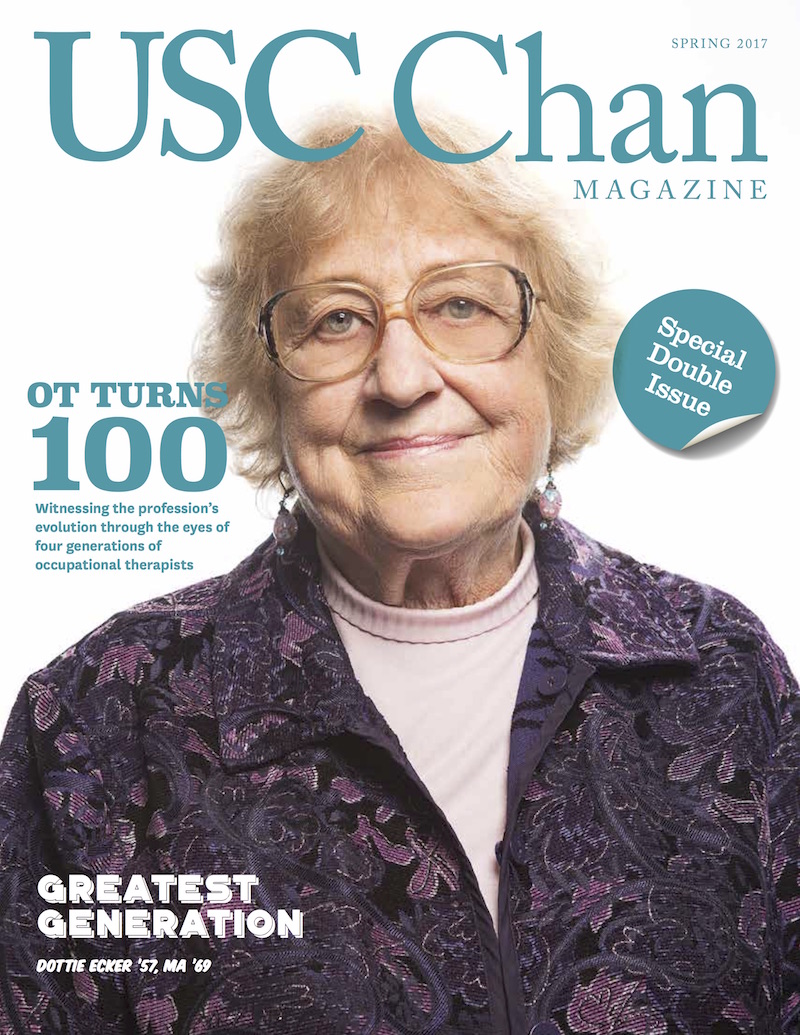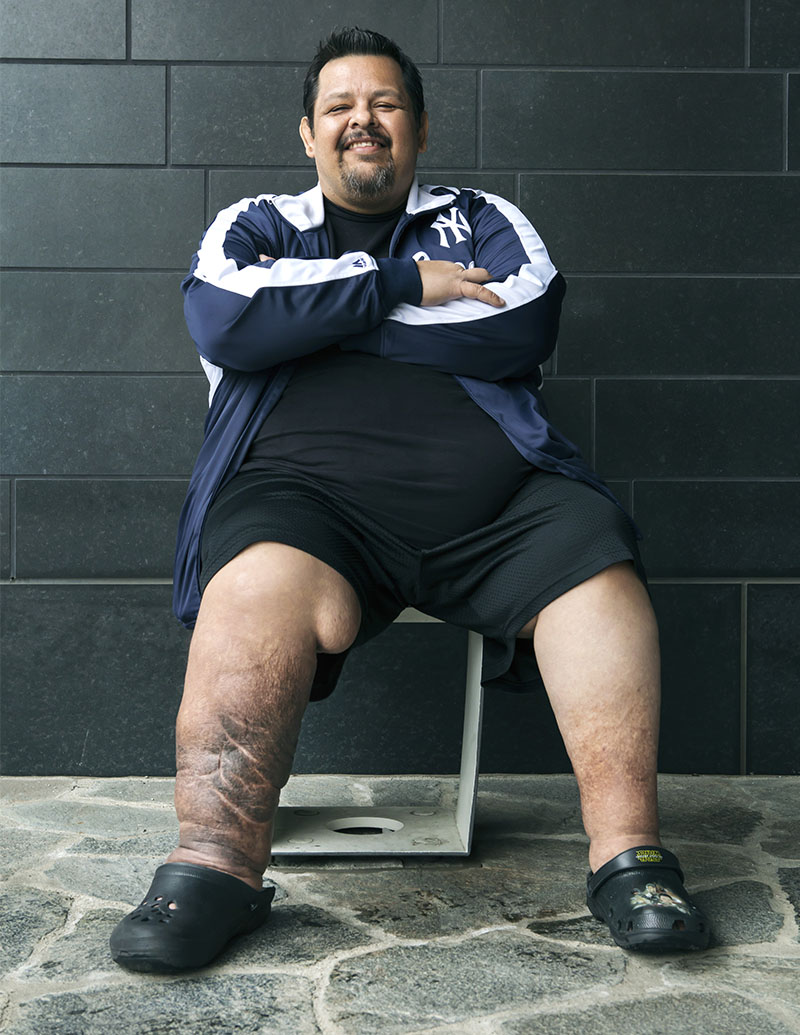A New Hope
USC Chan's faculty clinicians offer much-needed help for people living with lymphedema.
By Michelle McCarthy
Imagine having an ailment that swells one of your legs to four times its size — one that destroys your quality of life and brings with it immense pain and shame. For Salvador Castellanos, this nightmare was a reality.
“When I did go out, I couldn’t wear pants,” Castellanos says. “I would have to wear shorts. People would look at me in a weird way like, ‘Don’t get too close to this guy because he’s going to give you what he has.’ The hardest thing was not being able to take my kids to football and baseball practice. It would break my heart all the time. One day, I cried to God and asked him to send someone who would be able to help me.”
USC Chan occupational therapists taught Salvador Castellanos and his wife Jesse massage and wrapping techniques to keep the swelling down in his right leg | Photo by Nate Jensen
After a challenging four-year journey, the father of three was eventually diagnosed with lymphedema, an accumulation of fluid in the body that causes severe swelling. But thanks to a cutting-edge surgery being performed by Ketan Patel of the Keck School of Medicine of USC and the work of USC Chan occupational therapists, patients like Castellanos no longer have to suffer through this type of pain.
In his experience, Castellanos says there is an overall lack of awareness among physicians about lymphedema; and those who do recognize the symptoms don’t know how to help those afflicted by it, other than prescribing antibiotics for cellulitis — a common skin infection caused by lymphedema — and sending them home. And that’s what sets the occupational therapists at Keck apart.
“There are a handful of us who are certified lymphedema therapists who took a specialty course to treat patients with this condition,” says Michelle Hsia MA ’08, OTD ’09, assistant professor of clinical occupational therapy and manager of the department at Keck.
“A lot of times, we’ll get referrals from community hospitals, and the patient tells us, ‘I’ve had swelling in my leg for five years and went from doctor to doctor and they just told me I was fat. Or they told me it will go away.’ Sometimes they’ll come on their own, not even knowing what lymphedema is, and say, ‘Help me with my leg.’”
While Castellanos has primary lymphedema (occurring on its own), the ailment can also be a by-product of chemotherapy, radiation or cancer-related surgery in which lymph nodes are removed or damaged.
After being diagnosed with breast cancer in 2012, Sabrena Lee had a mastectomy and the removal of cancerous lymph nodes. Following radiation, she started noticing her affected arm was beginning to swell.
“I went to doctors and they would just give me a compression sleeve,” Lee says. “I’m a hairstylist, so I was taking anti-inflammatories every night because my arm was in so much pain and so heavy. I didn’t really want to go anywhere, so I stayed home. I had gotten to the point where I’d given up and was like, ‘This is what my life is going to be.’”
Sabrena Lee developed lymphedema in her right arm after undergoing a mastectomy and removal of cancerous lymph nodes | Photo by Nate Jensen
Castellanos and Lee both found their way to the lymphedema clinic at Keck Hospital where USC Chan occupational therapists are devoted to helping patients who are prepping to undergo surgery along with those who need to learn how to manage the lifelong ailment.
“In therapy, we do bandaging to bring down the swelling, massage, skin care education and exercise,” Hsia says. “Lymphedema changes your skin to a tree-bark texture because over time there is so much fluid that there’s no oxygen getting to the tissue. Manual lymphatic drainage is a type of massage that helps to open up the lymphatic system and push the fluid away. Once the swelling is down, we give the patients some sort of compression that keeps them at that smallest size we’ve achieved.”
Castellanos says the occupational therapists at Keck painstakingly taught him and his wife massage techniques and how to wrap his leg. “They would explain everything in detail. My wife learned how to wrap it just as well as the therapists,” he says. “So when we came home, she knew everything to do.”
A lot of the pre-surgical work the occupational therapists do involves educating their patients about what to expect from surgery, but it also includes understanding how it will impact their everyday lives once they go home.
“We talk about how to change diapers, how to carry a 20-pound baby when you’re not supposed to be lifting anything, sex and positioning, clothing, fatigue and exercise,” Hsia explains. “‘How are you going to get into the bed? How are you going to bathe and get dressed? What are the things that are important for you to do independently?’”
After Lee completed a month and a half of therapy, Patel performed a lymph node transfer surgery, a relatively new approach in which lymph nodes were taken from a healthy area in her body and placed in the limb affected by lymphedema to help drain fluid.
“I noticed a difference right away, and it gets better and better,” Lee says. “The main thing I noticed was that I wasn’t in pain.”
A second option is a lymphovenus surgery, where pathways in the lymph and venus systems are reconnected to improve flow.
“At the end of treatment, I’ve had patients say, ‘I don’t have any pain in my arm,’” Hsia says. “‘Now it doesn’t wake me up in the middle of the night.’ That makes a huge difference. They still have to wear a compression sleeve and manage the lymphedema, but they say, ‘I will take this over what I was experiencing before any day.’”
Castellanos is currently undergoing pre-surgical testing and is hoping to schedule lymph node transfer this summer. He says the therapy program at Keck has changed his life.
“I just went to one of my son’s baseball tournaments in Perris and got to see him play baseball for the first time,” he says with a big smile. “Now I feel much better going out. I put on a pair of sweatpants the other day and was like, ‘Wow, you can’t even tell my leg is swollen.’ I know there is a long road ahead of me, but I’m really happy with the outcome of everything.”
⋯








